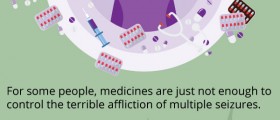
Overview of Epilepsy
Epilepsy is a neurological disorder that produces repeated seizures or fits. In most cases epilepsy starts in childhood but it is not uncommon to develop it at a later stage in life. In the United Kingdom, around 500,000 individuals are currently suffering from the disorder, i.e. 1 in every 130 persons has epilepsy. Further, the neurons in the brain communicate by sending signals to each other. During a seizure they are firing out of control causing muscle spasms and sometimes fainting. The intensity of seizures varies from person to person and can range from relatively mild to really severe. In addition, there are three distinct types of epilepsy including symptomatic, cryptogenic, and idiopathic epilepsy. The systematic kind of epilepsy is produced by an identified damage or disruption in the brain. The cryptogenic epilepsy is characterized by both seizures and accompanying disorders such as a learning disability, which suggest the damage to the brain has been done but experts are unable to locate it. In the case of idiopathic epilepsy no apparent cause can be identified for the recurring seizures. Although a long term disorder, the outlook for most people is generally positive as the symptoms for epilepsy can be controlled with anti-epileptic drugs. As is the case with any illness, it might take a little time before the right type and dosage of medication can be found but once it is established the patient can go on and live a fulfilling life.
Diagnosing EpilepsyIn some instances epilepsy can be somewhat challenging to diagnose as some of the symptoms can be similar to those of migraines or panic attacks. The primary health care provider refers the patient to a neurologist who performs a thorough assessment. One of the first things will be explaining in detail the circumstances of the seizures or seizure, what preceded them, how the person felt right before and after, and whether there were any warning signs. It is advised that people with seizures keep journals and talk to witnesses in order to establish a clearer picture. Next, the doctor will be interested to know about the patient’s medical history and whether he or she is taking any drugs or alcohol. Finally, image scanning will be utilized to identify any strange brain activity or spot any structural defects in the brain. For instance, one of the commonly used tests is an EEG, which measures brain activity through electrodes positioned on the head. A technician performing the test will ask the patient to close their eyes, breathe deeply, and perhaps look at a flashing light. If the flashing light triggers a seizure the test will be stopped. Another commonly used test is an MRI, which aside from structural defects as possible causes of epilepsy can also detect tumors.
Living a Life with Seizures
In order to successfully manage epilepsy it is crucial that the person identifies the triggers which lead to seizures and stay away from them as much as possible. Also, anti-epilepsy medications help in about 70 percent of cases and working closely with a specialist increases the patient’s chance of keeping their condition under control. The therapy is different from person to person and the adequate drugs have to be taken exactly as prescribed in order to be effective. Also, the patient should have regular checkups and reviews of both the changes in the condition and the effects of therapy. In cases in which epilepsy is not yet under control the reviews are more frequent. In addition, in order for any kind of treatment to be successful the person has to be disciplined and take good care of their overall health. Eating healthy and engaging in physical activity on a regular basis are very important components of both treatment and a general well-being. Staying away from stressors as well as learning to maintain stress and other adverse agents affecting mental health also helps speed up the process of therapy. Experts agree that people suffering from long term conditions benefit greatly from self-care in terms of prolonging life, feeling less pain, depression, and anxiety, and having an overall better quality of life. On the other hand, consuming alcohol can trigger seizures in some people and interfere with the anti-epileptic medications decreasing their desired effects and increasing the side effects. Seizures can also be triggered if the drinking disrupts the sleeping patterns in a person. Not more than a couple of glasses of wine or beer are recommended for women on a daily basis, and perhaps three of four at the most for men.Children with Epilepsy
If placed under the right type of therapy, a child with epilepsy can participate in the social and educational activities at school, and be completely unaffected by the condition. It is very important that the teachers and school nurses be aware of the child’s illness as well as the medications and other possible methods of treatment.
















Your thoughts on this
Loading...